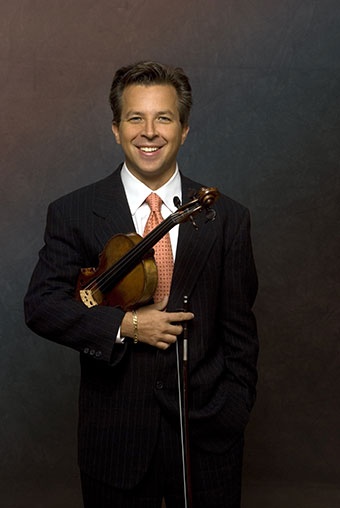A BPO 75th Anniversary Gift
by Jan Jezioro

BPO presents the world premiere of a violin concerto by Daron Hagen
BPO music director JoAnn Falletta is one very busy musician. Just as this article was about to go to press, the BPO announced that Falletta had been appointed as principal conductor of the Ulster Orchestra in Belfast, Northern Ireland, for the 2011-2012 season. Falletta will assume the new post while continuing to serve as the music director of both the BPO and the Virginia Symphony, and principal guest conductor of the Brevard Music Center, a summer institute and festival in North Carolina.
Falletta will be on the podium for the three M&T Bank Classic Series concerts this weekend (Friday, May 13 at 10:30am, Saturday, May 14 at 8pm, and Sunday, May 15 at 2:30pm) that will feature the world premiere of Songbook for Solo Violin, Strings, Harp and Percussion, by the contemporary American composer Daron Hagen. Hagen and Falletta studied together at Julliard, and she has become a strong advocate for his music, performing it in several different venues, most notably with the BPO, where she has programmed Hagen’s Concerto for Piano Left Hand, with pianist Gary Graffman in 2002. In one of the most challenging programming choices during her 10-year tenure as BPO music director, Falletta also presented a concert performance in 2006 of Hagen’s opera Shining Brow, based on the events that occurred between 1903 and 1914 during the great American architect Frank Lloyd Wright’s life.
The first night of the BPO’s two-concert performance run of Shining Brow took place on November 4, Hagen’s birthday, and as he and Falletta, along with BPO concertmaster Michael Ludwig, celebrated the event at a post-concert dinner, the idea for a new concerto for violin had its genesis. “Michael’s beautiful, singing tone during the many prominent violin solos in the opera’s score moved me to suggest that we make a violin concerto together,” Hagen writes.
“Daron Hagen has a special gift for song that has been beautifully developed in his large numbers of compositions for voice,” Falletta says. “Daron and Michael Ludwig discovered that they had a mutual love for all kinds of American popular songs, with a particular affection for the large body of American folk songs that they both feel remains the continuing font of American music. Daron was especially taken by Michael Ludwig’s very song-like, cantabile style of playing, during the BPO’s performance of Shining Brow, so much so that his idea to compose a concerto for violin for Michael was born on that night, though I knew nothing about it until much later.”
When Falletta received the score for Hagen’s new concerto, Songbook, she says, “It was a beautiful surprise. Daron has a special gift for song, and as he thinks vocally when composing in any genre, it was thrilling to read through the score for Songbook for the first time and see how it unfolded.”
Camerata di Sant’Antonio
The final Camerata di Sant’Antonio concert for this season takes place at 7pm on Sunday, May 15, at St. Anthony of Padua Church, 160 Court Street behind Buffalo City Hall. The concert features the local premiere of Astor Piazzolla’s Piezas para orquesta de camara, Vivaldi’s L’Estro Armonico Op.3 No.10, a concerto for four violins with soloists Marilynn Kregal, Nadia Nigrin, Diana Sachs, and Loren Silvertrust, as well as Tchaikovsky’s sunny Souvenir de Florence, a work that the group has not performed since 2004. Champagne will be served on the piazza beforehand, weather permitting, with a reception to follow.
Tickets are $17. For more information, call 854-2563.
Hagen found additional inspiration for the four tunes that he chose for his work in the singing of folk songs and spirituals by his wife, a professional composer and singer, to the couple’s baby son. The work begins with nine variations on “Cailín Óg a Stór,” a 16th-century Irish air that figures prominently in James Joyce’s writings as “The Croppy Boy,” one of the saddest songs about the Irish rising of 1798. The harmonies that underpin another Irish ballad, “The Praties,” dealing with the devastating potato famine of 1840, inspired the second movement in the form of a chaconne. “Look Away,” one of the best known traditional Appalachian folk songs, forms the basis for the third movement, written in the form of a passacaglia, while the final movement is a set of variations on “Amazing Grace.”
“The finale bookends the work by picking up with a tenth variation on ‘Croppy Boy’ before overlaying ‘Amazing Grace’ and the other tunes,” Hagen says. “The effect is sort of like listening to a composer juggle—atop of it, one after the other for a series of five more variations, ending with one marked ‘quasi un mbira’—a mbira being an African thumb piano.”
Morton Gould’s Stephen Foster Gallery, based on the works of 19th-century America’s most popular song composer, is also on the program, along with Beethoven’s expansively genial Symphony No. 6 in F Major, Pastoral.
For tickets and more information, call 885-5000 or visit www.bpo.org.
blog comments powered by Disqus|
Issue Navigation> Issue Index > v10n19 (week of Thursday, May 12th) > A BPO 75th Anniversary Gift This Week's Issue • Artvoice Daily • Artvoice TV • Events Calendar • Classifieds |









 Current Issue
Current Issue